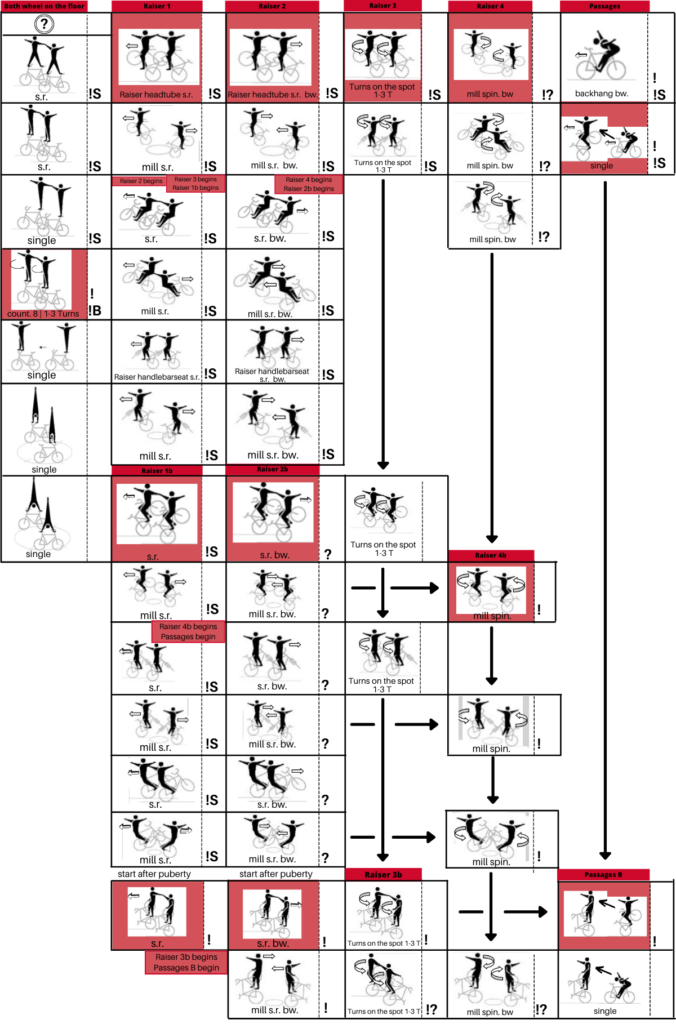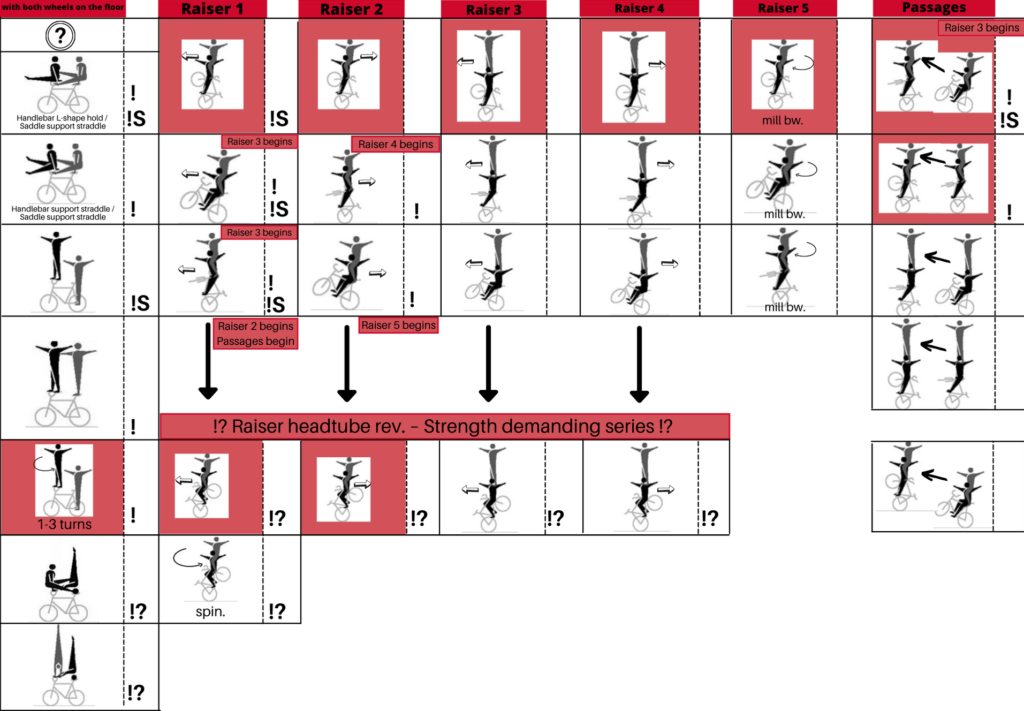This methodical guideline (provided by Dieter Maute) is offering an overview about the artistic cycling figures. It is a recommendation with which figures you can start the training and it shows which figures are based on another. These guidelines enable you to build up your training lessons and help to create the performance and to raise the difficulty of the figures step by step.
Figures on two bikes

References
Figures with a colored background are basic figures that create prerequisites for a whole series of figures or have a transfer effect. They are therefore particularly important.
It is also possible to do pair figures on 2 bikes, which can be mastered with single training without great learning effort.
The entry into pair artistic cycling is more easily when these figures are mastered individually from the basic training (single artistic cycling) and the physical conditions for the demanding figures on 1 bike (core strength) have been created.
.
No other correct picture available.
Not the preferred methodological path, however depending on the pair riders is still possible.
Handlebarstand turn: It is important to acquire the correct technique to enable the enlargment to Handlebarstand 3 turns.
Raiser reg. seat rev. bw./Raiser handlebarseat rev. bw./Raiser headtube rev. bw.: This three raiser figures are not essential.
Raiser 4b Raiser headtube rev. mill spin.: Start as soon as the Raiser headtube rev. is driven in the technically correct manner.
Raiser 4b Raiser handlebarseat rev. mill spin: Start as soon as the Raiser headtube rev. is driven in the technically correct manner.
Raiser 4b Raiser reg. seat rev. mill spin: Start as soon as the Raiser reg. seat rev. is driven in the technically correct manner.
Raiser 4b Standriaser mill spin. bw.: as soon as the standraiser bw. has a correct technic.
Standraiser s.r.: Standraiser s.r. is not essensial. Standraiser must be learned in a way that the correct body-bike position allows short straight line forward to be ridden.
Standraiser s.r. bw. / Standraiser mill s.r. bw.: Standraiser s.r bw. is not absolutely essential, because in order to prepare the figure, the riders need to change the grip position. Standraiser mill s.r. bw. is required, as this leads to the figure Standraiser Mill spin. bw.
Raiser handlebarseat turns: Not essential figure. Raiser headtube, Raiser headtube rev., Raiser handlebarseat rev. are preferred turns as this one.
Standraiser 1-3 turn: Begin as soon as a short straight line forward at the Standraiser can be ridden.
Standraiser rev. 1-3 turns: Learn Standraiser rev. first so that a little straight line forward can be ridden in the correct body-bike position. (Possibly uninteresting in terms of time)
Backhang bw.: It is a prerequisite for the Passage backhang raiser headtube rev. In that way, backhang bw. should be learned with enough time.
Passage backhang raiser headtube rev.: In contrast to the single discipline, in pairs when doing this passage the riders start riding forward as soon as reached the raiser headtube rev. The passage backhang raiser headtube rev. provides a transfer to the passage backhang standraiser and must therefore be learned correctly from a technical point of view.
Passage raiser headtube rev. standraiser: The the passage raiser headtube rev. standraiser should be learned first and provide a transfer to the passage backhang standraiser. The passage should therefore be be learned in good time and in the correct technical manner.
Figures on one bike

Figures with a colores background are basic figures that create prerequisites for a whole series of figures or have a transfer effect. They are therefore particularly important.
It is also possible to do pair figures on 1 bike, which can be learned through the single training and can be mastered without much effort. (e.g. Reg. seat/handlebarstand, frontstand/stand on pins, frontstand/saddlestand, handlebarseat/stand on pins, … ). Figures marked with a question mark can be skipped depending on the learning progress and capability.
It makes most sense to start with the pair figures, if these figures are mastered in the single training and the physical prerequisites for the effort of the figures on 1 bike (torso strength) have been achieved.
Methodical alternatives, depending on the constitution and conditions of the pair.
Handlebar L-shape hold / Saddle support straddle and Handlebar support straddle / Saddle support straddle: For these figures the Saddle support straddle does not have to be learned individually if this has not yet been done in the single training. not yet done. It is sufficient if a rider is able to do the Handlebar L-shape hold or the Handlebar support straddle.
Handlebarstand / Stand on pins: Must be ridden safely before the Handlebarstand turns / Stand on pins can be started.
Handlebarstand / Saddlestand: Takes a lot of time and is not essentially needed later due to the too low point value. Therefore it is not necessary to learn. (A correction in the regulations would be desirable).
Handlebarstand turns / Stand on pins: The first handlebarstand turn should be learned individually, i.e. without a partner in the Stand on pins. Important is the correct technique to allow the enlargement to the Handlebarstand 3 turn.
Headstand / Handlebar handstand ; Headstand / Handlebar support straddle handstand: Are an alternative for the Raiser headtube rev. strength demanding series. Depending on the conditions constituted from the pair of riders. Eventually both figures can be performed.
Raiser reg. seat / Shoulderseat and Raiser handlebarseat / Shoulderseat: The Raiser reg. seat is more difficult than the raiser handlebarseat , but because of the the risk of falling in the case of the Raiser handlebarseat and the greater fear associated with it, the Raiser handlebarseat bw. can be well secured and can therefore also be trained before the Raiser reg. seat bw.
Raiser headtube rev. strength demanding serie: Whether to star and when to star with the Raiser headtube rev. strength demanding serie depends on the state of training, the constitution of both riders of the pair and, on the learning progress. Depending on the constitution of the pairs, the Raiser headtube rev. strength demanding serie can also be ridden by the other rider as the person who is supporting to reduce the effort.
Raiser headtube rev. / Shoulderseat: When the Raiser headtube rev. / Shoulderseat is going to be ridden, the Raiser headtube rev. bw. / Shoulderseat and the Raiser headtube rev. / Shoulderstand can be started at the same time.
Passage Raiser reg. seat – Raiser handlebarseat / Shoulderseat : Correct technique must be learned in such a way that the P. Raiser reg. seat – Raiser handlebarseat / Shoulderstand is possible.
Passage Raiser handlebarseat – Raiser headtube / Shoulderseat: The correct technique must be learned in such a way that the P. Raiser handlebarseat – Raiser headtube / Shoulderstand is possible
